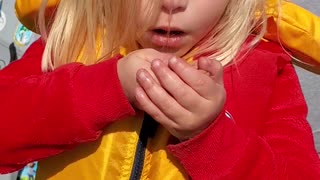Premium Only Content

Dolphin kisses a little girl and brings her a gift
An adorable little girl kisses the Dolphins.
As the crowd watches on an adorable little girl in a small orange and white boat with the supervision of a woman. She greets the dolphins as they swim up to meet her. The little girl leans over and gave the dolphins a lovely greeting. The dolphins show their appreciation by bringing a gift to the beautiful little girl and gets a kiss from her, it's a heartwarming event that you have to see for yourselves.
Dolphins are small-toothed cetaceans easily recognizable by their curved mouths, which give them a permanent “smile.” There are 36 dolphin species, found in every ocean. Most dolphins are marine and live in the ocean or brackish waters along coastlines. There are a few species, however, like the South Asian river dolphin and the Amazon river dolphin, or boto, that live in freshwater streams and rivers.
The largest dolphin, the orca, can grow to be over 30 feet long. The smallest, the Maui dolphin, is just five feet long.
Dolphins feed chiefly on fish and squid, which they track using echolocation, a built-in sonar that bounces sound waves off prey and reveals information like its location, size, and shape. An echolocating bottlenose dolphin can make up to a thousand clicking noises per second.
Behavior and reproduction
Living in pods that can number a dozen or more, dolphins are intensely social mammals that communicate with squeaks, whistles, and clicks. Whether dolphins have language, as humans do, is a topic that scientists have debated for decades.
As mammals, they have warm blood and nurse their young. Dolphins have more than one mate, and generally produce a single offspring that will stay with the mother for up to six years, depending on the species.
Dolphins are graceful, sleek swimmers that can reach speeds of more than 18 miles an hour. They are also playful and often frolic in a boat’s wake, leaping out of the water—possibly for fun, to communicate, or even shed pesky parasites.
Threats
For centuries, people have hunted dolphins for their meat and blubber. Today, their main threat comes from being caught accidentally in commercial fishing nets. Dolphins must rise regularly to the surface to breathe—becoming entangled in nets prevents this, leading to drowning. For maine dolphins, warming ocean temperatures because of climate change have caused some of their primary food sources to move into deeper, cooler water. Furthermore, marine heatwaves, also caused by climate change, appear to have a negative affect on dolphins' reproductive rates and ability to survive.
In addition to hunting and entanglement in fishing gear, freshwater dolphins face the additional threat of dams fragmenting and degrading habitat.
-
 0:18
0:18
x4xbazzyx4x
3 years agoLittle Girl Kisses Worm and throws Him in the Water
481 -
 LIVE
LIVE
The Rubin Report
40 minutes ago'Real Time' Crowd Stunned as Bill Maher Gives a Brutal Message to Democrats
3,617 watching -
 LIVE
LIVE
Benny Johnson
27 minutes agoDC Swamp Declares WAR on TRUMP in Senate Battle to REPLACE Mitch McConnell! We EXPOSED Secret Ballot
5,534 watching -
 LIVE
LIVE
Caleb Hammer
12 hours agoPsycho Tried To Manipulate Me | Financial Audit
117 watching -
 LIVE
LIVE
LFA TV
11 hours agoJUSTICE IS COMING! | LIVE FROM AMERICA 11.11.24 11am EST
4,855 watching -
 LIVE
LIVE
Matt Kohrs
14 hours agoEXPLOSIVE NEW HIGHS!!! (Bitcoin, Tesla, Coinbase & DJT) || The MK Show
1,580 watching -
 37:18
37:18
BonginoReport
4 hours agoInside the Neocons' Plan to Thwart Trump (Ep.82) - 11/11/24
104 -
 1:58:06
1:58:06
Jeff Ahern
2 hours agoMonday Madness with Jeff Ahern
1 -
 1:27:53
1:27:53
Game On!
11 hours agoI lost $591,000 on the New York Giants! I HATE THEM!
1541 -
 35:35
35:35
The Why Files
6 days agoThe Dark Side of the Moon | Alien Activity and the NASA Cover-Up
74.9K121